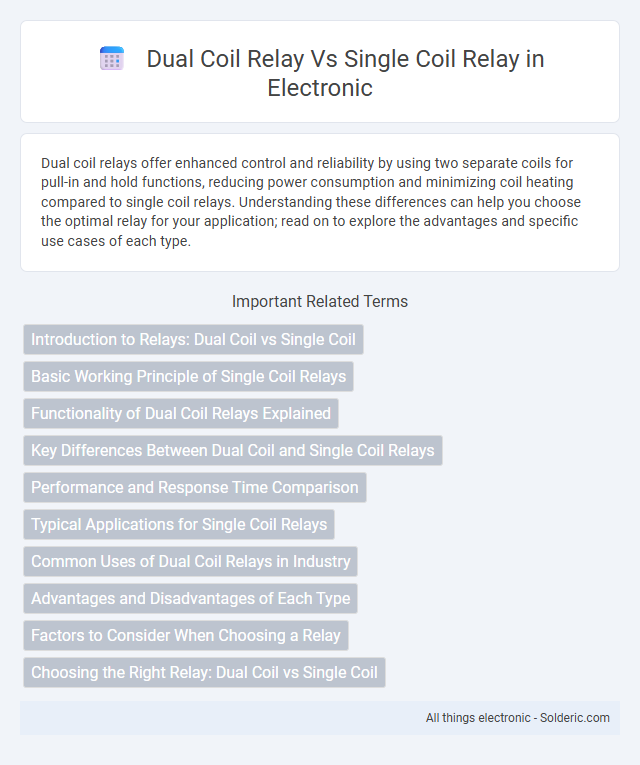Dual coil relays offer enhanced control and reliability by using two separate coils for pull-in and hold functions, reducing power consumption and minimizing coil heating compared to single coil relays. Understanding these differences can help you choose the optimal relay for your application; read on to explore the advantages and specific use cases of each type.
Comparison Table
| Feature | Dual Coil Relay | Single Coil Relay |
|---|---|---|
| Coil Count | Two coils | One coil |
| Operation | One coil for pull-in, other for drop-out | Single coil for both pull-in and drop-out |
| Power Consumption | Lower power during holding (only one coil energized) | Constant power while energized |
| Switching Speed | Faster switching due to separate coils | Moderate switching speed |
| Complexity | More complex wiring and control | Simpler design and control |
| Applications | Used in latching applications and low power hold circuits | Used in general switching tasks |
| Cost | Generally higher | Generally lower |
| Reliability | Higher durability due to less coil heating | Potential for coil overheating on continuous use |
Introduction to Relays: Dual Coil vs Single Coil
Dual coil relays feature two separate coils that control the relay's switching operation, offering precise control and stable switching performance without requiring a continuous power supply to maintain the state. Single coil relays use one coil to both actuate and hold the relay, which simplifies the circuit design but may consume more power to keep the relay engaged. Understanding the differences between dual coil and single coil relays helps you choose the right component for applications requiring efficient power management and reliable switching.
Basic Working Principle of Single Coil Relays
Single coil relays operate using a single electromagnetic coil that creates a magnetic field when energized, pulling the armature to close or open contacts and complete the circuit. This magnetic action enables your control system to switch electrical loads efficiently with minimal external components. In contrast, dual coil relays use two coils to control the armature's position, offering bistable switching but with increased complexity compared to the straightforward design of single coil relays.
Functionality of Dual Coil Relays Explained
Dual coil relays feature two separate coils for distinct operations such as pull-in and drop-out, enhancing control precision and reducing power consumption compared to single coil relays. The dual coil design allows one coil to engage the relay armature, while the second coil holds it in position, improving reliability in applications requiring stable switching. This functionality makes dual coil relays ideal for circuits demanding energy efficiency and robust mechanical performance.
Key Differences Between Dual Coil and Single Coil Relays
Dual coil relays utilize two separate coils to control the switching mechanism, enabling bistable operation and reducing power consumption by maintaining the relay state without continuous energizing. Single coil relays operate with one coil, requiring continuous current to maintain the activated position, which can lead to higher power usage and heat generation. Dual coil relays often provide enhanced reliability and energy efficiency in applications requiring frequent switching compared to single coil relays.
Performance and Response Time Comparison
Dual coil relays exhibit faster response times and improved performance due to separate coils for pull-in and drop-out functions, reducing power consumption and heat generation. Single coil relays use one coil for both actions, resulting in slower switching speed and higher energy usage. Consequently, dual coil relays deliver enhanced electromagnetic efficiency and longer operational lifespan in high-frequency switching applications.
Typical Applications for Single Coil Relays
Single coil relays are commonly used in automotive circuits for switching headlights, fuel pumps, and horn systems due to their simple design and efficient operation. In industrial automation, single coil relays facilitate motor control, lighting systems, and basic signal switching where cost-effectiveness and reliability are crucial. These relays are also prevalent in household appliances for switching low to moderate power loads, providing straightforward control solutions without complex circuitry requirements.
Common Uses of Dual Coil Relays in Industry
Dual coil relays are commonly used in industries requiring precise control and fail-safe operation, such as motor control circuits and automation systems. Their dual coil design allows for latching relays that maintain position without continuous power, improving energy efficiency in manufacturing equipment and HVAC systems. You will find these relays frequently applied in robotics, conveyor systems, and safety interlocks where reliable switching and reduced power consumption are critical.
Advantages and Disadvantages of Each Type
Dual coil relays offer the advantage of reduced power consumption and lower heat generation compared to single coil relays, enhancing energy efficiency in your circuit. Single coil relays are simpler in design and more cost-effective, but they tend to draw continuous current while energized, potentially causing coil overheating. Each type balances trade-offs between efficiency and simplicity, making your choice dependent on specific application requirements like power consumption and durability.
Factors to Consider When Choosing a Relay
When choosing a relay, consider coil voltage requirements, switching capacity, and control complexity between dual coil and single coil relays. Dual coil relays offer more precise control and fail-safe operation by using separate energizing coils, which may be critical for applications requiring reliable switching under varying voltage conditions. Your selection should factor in the application's voltage tolerance, switching speed, and the need for isolation or redundancy to ensure optimal performance and durability.
Choosing the Right Relay: Dual Coil vs Single Coil
Choosing the right relay depends on your application requirements, where a dual coil relay provides enhanced control by allowing separate energizing and de-energizing coils, improving reliability and reducing contact wear. Single coil relays are simpler and cost-effective, suitable for basic switching tasks but may experience more mechanical stress during operation. Your choice should consider factors like switching speed, durability, and complexity to ensure optimal performance.
dual coil relay vs single coil relay Infographic

 solderic.com
solderic.com